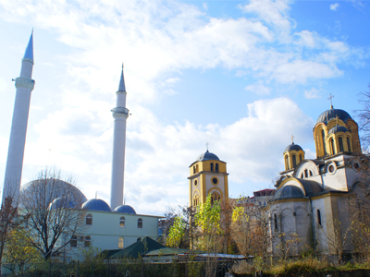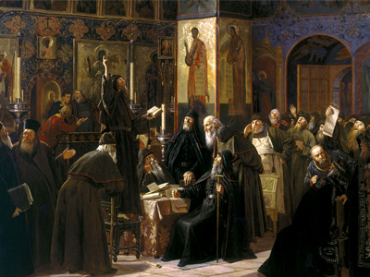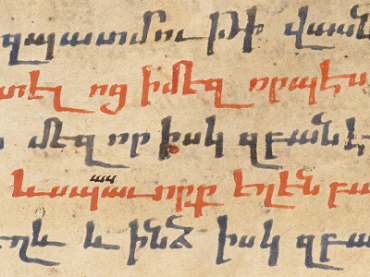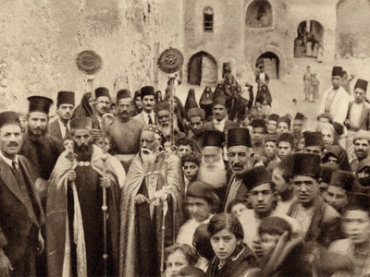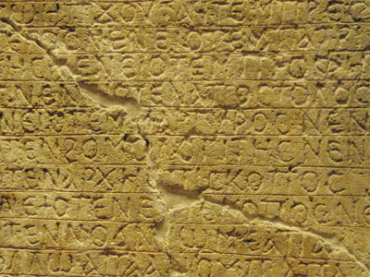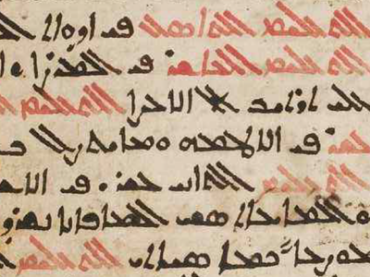Syriac and Eastern Christianity
Christianity and Christian Literature in Arabia before Islam
Le Christianisme et la Litterature Chrétienne en Arabie avant l'Islam
Series: Christianity in the Islamic World 3
ISBN: 978-1-59333-547-2
The relationship between early Christianity in Arabia and the development of Islam was a question that absorbed Louis Cheikho’s attention. In this Arabic volume he directly addresses Christianity and Christian literature in Arabia before the rise of Islam.
$238.00
Chaldean-Arabic Dictionary
Introduction by George A. Kiraz
By Eugene Manna
Series: Kiraz Historical Dictionaries Archive 6
ISBN: 978-1-59333-552-6
A historical dictionary translating Syriac into Arabic, this handy volume brings together the language of the author’s Chaldean Church and the Arabic of his contemporary culture. This scarce volume, now available in the west, is sure to be of considerable interest to scholars of Syriac and Arabic alike.
$298.00
Rhythms of Saint Ephrem the Syrian
Select Works of S. Ephrem the Syrian
Series: Kiraz Theological Archive 31
ISBN: 978-1-59333-561-8
As a member of the Oxford Movement, Morris had a natural fascination with Eastern Christianity. Using his linguistic skills to translate select works of St. Ephrem into English, he chose those that would create an impact on his fellow Englishmen in the nineteenth century. These works are still treasured by western proponents of Eastern Christianity today.
$198.00
Nestorian Missionary Enterprise
The Story of a Church on Fire
By John Stewart
Series: Christianity in the Islamic World 4
ISBN: 978-1-59333-563-2
Consistently referenced as a reliable source on the "Nestorian" missionary movement, this historical account of that movement is a necessary volume for anyone interested in the missionary work of the Eastern Church. Stewart’s engaging account has remained fresh through the years and remains a standard reference on the topic.
$179.00
The Religion of Russia
A Study of the Orthodox Church in Russia from the Point of View of the Church in England
ISBN: 978-1-59333-566-3
G. B. H. Bishop was an Anglican priest who was killed in action during the First World War. His legacy to the ecumenical movement was this study of the Russian Orthodox Church, an early attempt to make this body accessible to the western world. He includes a history, summary of faith, practice, and hierarchy of the Church as well as his own observations.
$118.00
The Witness of the Vulgate, Peshitta and Septuagint to the Text of Zephaniah
Series: Analecta Gorgiana 25
ISBN: 978-1-59333-567-0
Zandstra focuses specifically on the text of the prophetic book of Zephaniah. Comparing the Latin Vulgate, the Syriac Peshitta, and the Greek Septuagint, against the original Hebrew of the text he concludes that these versions are interdependent. Zandstra also considers the variants between these primary witnesses and the Masoretic Text.
$45.00
Coptic-Latin Lexicon
Lexicon Copticum
Series: Kiraz Historical Dictionaries Archive 8
ISBN: 978-1-59333-571-7
Peyron’s lexicon is the classic Coptic-Latin dictionary of the early twentieth century. It is of special historical importance because of the association of Peyron with Champollion, Napoleon’s epigrapher on his Egyptian voyage. Placed so early in the dawn of Egyptian studies, Peyron sheds light from an eye undimmed by the subsequent decades of scholarship.
$273.00
Catalogue of Syriac Printed Books and Related Literature in the British Museum
By Cyril Moss
Series: Kiraz Historical Catalogues Archive 2
ISBN: 978-1-59333-607-3
Moss’s catalogue represents the first effort at providing a thorough, printed database of the various materials that make up the British Museum’s Syriac corpus. The catalogue includes not only Syriac manuscripts, but also a listing of books and articles concerning them.
$368.00
Eastern Crossroads
Essays on Medieval Christian Legacy
Series: Gorgias Eastern Christian Studies 1
ISBN: 978-1-59333-610-3
This volume contains papers from the First International Congress on Eastern Christianity held in Córdoba, Spain, November 2005. The encounter of medieval Christian writers with several linguistic traditions through the Middle Ages produced one of the most important branches of Middle Eastern literature. This encounter not only changed the nature of the respective writings throughout time, but also influenced considerably the development of the legacies transmitted by the writers and the scholars of various Eastern Christian churches.
$214.00
The Ancient Egyptians and the Origin of Civilization
ISBN: 978-1-59333-609-7
This monograph, in its second, hard-to-locate edition, proposes a connection between prehistoric monumental European sites and those of the Pyramid Age in Egypt. Using ethnicity as a basis, Smith ties the ancient peoples of Egypt to those of Syria and discusses how Egyptian culture spread from its point of origin.
$143.00
Aphraates and the Jews
A Study of the Controversial Homilies of the Persian Sage in their Relation to Jewish Thought
By Frank Gavin
Series: Analecta Gorgiana 29
ISBN: 978-1-59333-620-2
In the first English attempt to address the Syriac homilies of Aphraates, Gavin sets a context for the material by considering the church and the sermons themselves. The topic of how the Jews are treated in the homilies is given special attention.
$50.00
A Biblical Perspective
Series: Gorgias Eastern Christian Studies 2
ISBN: 978-1-59333-638-7
A popularly-written study of the biblical roots of the Eastern Orthodox Church’s mystical understanding of the knowledge of God. This unique study brings together the best of contemporary exegesis with the tradition of Eastern Christianity and illustrates the biblical roots of the Eastern Church's understanding of grace as the energy of God. The book presents, in lay terms, the shape for an Orthodox biblical theology for the 21st century and will be of interest to all Christians for whom the Bible is divine revelation and for whom tradition continues to be creative.
$82.00
History of the Za’faraan Monastery
By Ignatius Aphram I Barsoum; Translated by Matti Moosa
ISBN: 978-1-59333-639-4
The History of the Za’faran Monastery is for the first time offered in English translation to the readers. It was written in 1917 by Patriarch Ignatius Aphram Barsoum (d. 1957) when he was still a monk at the monastery. The book details the history of the monastery from its inception until modern times. It deals with with everything, from construction to its significance as a center of Syriac learning and learned men. Without this small book, the first of its kind, a great and significant page of the history of the Syrian Church of Antioch would have been lamentably lost.
$111.00
Ancient Egypt
Series: Kiraz Classic Archaeological Reprints 6
ISBN: 978-1-59333-651-6
Rawlinson’s study of ancient Egypt surveys the land and people of Egypt before taking the development of the nation through historic chapters. Told in a level of detail to rival Breasted’s classic work on Egypt, this earlier study makes fascinating reading.
$190.00
The Works of Sahdona (Martyrius)
With Homilies by Jacob of Sarug
By Paul Bedjan
ISBN: 978-1-59333-677-6
Bedjan presents Sahdona’s Book of Perfection, a significant resource for the study of East Syrian monasticism, and some shorter works. Also included are several homilies by Jacob of Sarug on Jesus, Mary, virginity and the Council of Nicea.
$302.00
The Book of the Dove
Edited by Paul Bedjan
ISBN: 978-1-59333-678-3
The Book of the Dove is the ascetical guide composed by Bar-Hebraeus for aspiring hermits. It concerns the training of the body and the soul for ascetical life. The spiritual rest of the perfect is also described, along with a spiritual autobiography of Bar-Hebraeus himself.
$139.00
The Metrical Grammar of Gregory Bar Hebraues
Gregorii Bar Hebraei Grammatica Linguae Syriacae in Metro Ephraemeo
Series: Kiraz Historical Grammars Archive 8
ISBN: 978-1-59333-681-3
One of the noted linguistic works of Gregory Bar-Hebraeus, this Grammar of the Syriac Language is presented here in the original Syriac along with a Latin translation by Ernst Bertheau. The text is fully annotated, also in Latin, giving it a wealth of information on ancient languages.
$122.00
The Origin of the Modern Syrian
Series: Analecta Gorgiana 39
ISBN: 978-1-59333-693-6
An extremely provocative text, Bishara pleads the case of the Arab-American to be seen and treated as equal members of American society. An insightful peek into Arab-American self-identity around the turn of the 20th century, Bishara’s essay is of interest to ethnographer and historian alike.
$44.00
The Mameluke or Slave Dynasty of Egypt 1260-1517 A.D.
By William Muir
ISBN: 978-1-59333-697-4
Alert to the implications of Egyptian politics to the world of the Middle Ages, Muir offers a detailed look at the rule of the slave-soldier caste known as the Mamelukes who ruled Egypt from 1260 to 1517. Each ruler of the Bahrite and Circassian dynasties is given a full chapter, and the role of the Mamelukes under the Ottoman Empire is reviewed.
$157.00
The Oldest Christian People
History and Traditions of the Assyrian People and the Fateful History of the Nestorian Church
ISBN: 1-59333-407-9
Gives a brief account of the history and traditions of the modern Assyrian people, and the fateful history of the Church of the East. The first seven Chapters are dedicated to the modern period, while the final six chapters discuss Christian-Muslim relations and the fate of the Church of the East and the Assyrian people during and after World War I.
$120.00
Gorgias Encyclopedic Dictionary of the Syriac Heritage
ISBN: 978-1-59333-714-8
The Gorgias Encyclopedic Dictionary of the Syriac Heritage (GEDSH) is the first major encyclopedia-type reference work devoted exclusively to Syriac Christianity, both as a field of scholarly inquiry and as the inheritance of Syriac Christians today. In more than 600 entries it covers the Syriac heritage from its beginnings in the first centuries of the Common Era up to the present day. Special attention is given to authors, literary works, scholars, and locations that are associated with the Classical Syriac tradition. Within this tradition, the diversity of Syriac Christianity is highlighted as well as Syriac Christianity’s broader literary and historical contexts, with major entries devoted to Greek and Arabic authors and more general themes, such as Syriac Christianity’s contacts with Judaism and Islam, and with Armenian, Coptic, Ethiopian, and Georgian Christianities.
$130.00
The History of Tur Abdin
English Translation by Matti Moosa
ISBN: 978-1-59333-715-5
Until now this first insider-history of Tur Abdin has been unavailable to non-Semitic readers. Written by Patriarch Ignatius Aphram Barsoum in Syriac, this history of the mountainous region in southeastern Asia Minor called Tur Abdin has not found wide readership because of language barriers. This new edition produced by Gorgias Press is a trilingual edition: the original Syriac, Arabic, and English translations.
$127.00
My Winter on the Nile
Series: Kiraz Historic Travels Archive 16
ISBN: 978-1-59333-723-0
From the eyes of a novelist, Warner illustrates the drama and romance of a voyage through Egypt. Particularly attracted to the Muslim life and practice in Egypt, and the monuments of the ancient empires, Warner takes the reader through the length of the country into Ethiopia and tropical Africa. A travelogue that captures the 19th century fascination with the East, this volume will delight anyone interested in Egypt.
$205.00
Travels in Turkey, Asia-Minor, Syria, and Across the Desert into Egypt
During the Years 1799, 1800, and 1801 in Company with the Turkish Army and the British Military Mission
Series: Kiraz Historic Travels Archive 17
ISBN: 978-1-59333-724-7
A historic travelogue with an eye toward the medical conditions encountered along the way, this rare book sheds light on western Asia from a unique vantage-point. Wittman describes his journey through Turkey, Syria, Palestine, and Egypt, noting along the way the diseases suffered by the residents, and brings the world of ancient western Asia to life through his vivid writing.
$251.00
Jacob of Sarug's Homily on the Chariot that Prophet Ezekiel Saw
Metrical Homilies of Mar Jacob of Sarug
Translation and Introduction by Alexander Golitzin; Edited with Notes by Mary T. Hansbury
Series: Texts from Christian Late Antiquity 3
ISBN: 978-1-59333-735-3
This volume gives a bilingual Syriac-English edition of Saint Jacob of Sarug’s homily on the Chariot which the Prophet Ezekiel saw. The Syriac text is fully vocalized, and the translation is annotated with a commentary and biblical references. The volume constitutes a fascicle of Gorgias’s Complete Homilies of Saint Jacob of Sarug. In Syriac and English.
$50.00
Filter by
Filter by price
Filter by manufacturer

